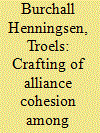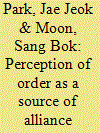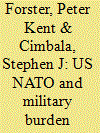|
|
|
Sort Order |
|
|
|
Items / Page
|
|
|
|
|
|
|
| Srl | Item |
| 1 |
ID:
173152


|
|
|
|
|
| Summary/Abstract |
The level of alliance cohesion is measured along the following dimensions of alliance operation: attitudinal, behavioural, and functional. However, it is insufficient to evaluate the level of cohesion only by examining how those indicators have changed over time. If it were sufficient to do so, it would presume the level of alliance cohesion would be bound to become similarly high in cases such as those of the US-Japan and US-Philippines alliances in which the commonly perceived threat is now widely and deeply entrenched. This article argues that the capabilities dimension be included in the list of indicators evaluating the level of cohesion. The US places greater emphasis on encouraging its allied partners to address specific capability gaps, foster trust, and improve jointness and interoperability with the US forces and thus contribute further to the evolution of division of alliance labour in which they take a larger role in both regional and global defense as well as cater for their own needs. The evolving division of labour that has been facilitated—and made possible—by a junior ally's enhanced capabilities has incentivized both the US and its ‘capable’ ally to work together to enhance alliance cohesion and credibility.
|
|
|
|
|
|
|
|
|
|
|
|
|
|
|
|
| 2 |
ID:
179280


|
|
|
|
|
| Summary/Abstract |
In spite of several international interventions to contain and degrade militant groups in the Sahel region, al-Qaeda affiliated groups have managed to retain their alliance and even spread and intensify their use of violence. This article explains the cohesion of the insurgency alliance as the outcome of a number of sound strategic decisions. By applying a framework of irregular strategy, the article examines the processes of early adaption to pre-existing social networks and the subsequent shaping through political, violent, and communicative lines of effort. Although the primary purpose of the strategy was not alliance cohesion, the result is that al-Qaeda related networks cooperate across ethnic and social cleavages, despite the many setbacks and dilemmas that local politics generate. The article adds an agency-oriented perspective to the growing literature on insurgency fragmentation and cohesion, which are major factors in the outcome of civil wars.
|
|
|
|
|
|
|
|
|
|
|
|
|
|
|
|
| 3 |
ID:
131880


|
|
|
|
|
| Publication |
2014.
|
| Summary/Abstract |
The level of alliance cohesion is affected by the shift of attitudinal aspects (such as homogeneity in goals and threat perceptions) and behavioural aspects (such as strategic compatibility, command structure and defence burden-sharing) of alliance operation. In particular, a clear threat perception tends to make an alliance cohesive, as it suppresses (potential) disputes over the behavioural aspects of alliance operation. This article argues, however, that it is not sufficient to evaluate whether an alliance is cohesive or not only by looking at how these attitudinal and behavioural indicators have changed over time. If it were sufficient to do so, it would be supposed that the level of alliance cohesion would be bound to become lower with a change of government from conservative political forces to liberal ones in cases such as those of the US-ROK and the US-Japan alliances. We argue that the list of indicators for alliance cohesion should include not only attitudinal and behavioural aspects of alliance operation, but also functional aspects. While serving its primary purpose of responding to a specific threat, an alliance incurs an additional function of serving to maintain or to build a favourable regional order that is appreciated by both liberal and conservative governments. The interests in relation to order-building and order-maintenance motivate allies to invest for the alliance, often at their own political risk, even while they are engaged in contentious negotiations with the United States over attitudinal and behavioural aspects of alliance operations. Such investments can be considered as a different type of alliance burden sharing than has heretofore been given adequate attention. The investments indeed consolidate the alliance, paving the way for further upgrading of the alliance as conditions warrant.
|
|
|
|
|
|
|
|
|
|
|
|
|
|
|
|
| 4 |
ID:
154333


|
|
|
|
|
| Summary/Abstract |
NATO burden sharing has become an especially timely issue in the past several years as a result of a number of factors, including Russian annexation of Crimea and destabilization of eastern Ukraine in 2014. This article argues that alliance unity among the great democracies of Europe and North America is indispensable to peace and stability on the Eurasian continent. A fractured NATO, and especially, a large divide in purposes or commitments as between the United States and its European security partners, invites aggression and the possibility of inadvertent escalation. Past successes and failures in US-involved multinational peace and stability operations, within and outside of Europe, show that mission accomplishment requires give and take, including the occasional acceptance of unequal costs and benefits among the members, in order to achieve peace and security objectives.
|
|
|
|
|
|
|
|
|
|
|
|
|
|
|
|
|
|
|
|
|